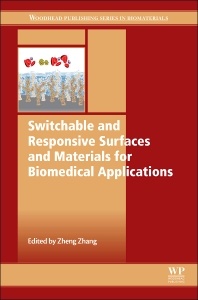Description
Switchable and Responsive Surfaces and Materials for Biomedical Applications
Woodhead Publishing Series in Biomaterials Series
Coordinator: Zhang Johnathan
Language: English
Subjects for Switchable and Responsive Surfaces and Materials for...:
Keywords
Actuators; Betaines; Biocompatibility; Biointerface; Biomedical applications; Biomedical uses; Biosensors; Cell culture carriers; Cell sheet engineering; Cellmaterial interaction; Focal adhesion signaling; Geometry sensing; Implants; Interactions on biosurfaces; Medical devices; Medical implants; N-isopropylacrylamide; Optobioelectronic devices; Peptides; pH responsive; Photo switches; Photo-stimulus; Photonic sensitive materials; PIPAAm; Polyampholytes; Polyelectrolytes; Polymer brushes; Polymeric particles; Protein adsorption; Proteins; Responsive; Responsive polymers; Site-specific drug delivery; Stimuli-responsive surfaces; Stimulus responsive; Surface modification & characterization; Switchable materials; Temperature-responsive cell culture surface; Thermo-responsive copolymers; Thermo-responsive polymers; Thin films diagnostics; Zwitterionic polymers
324 p. · 15x22.8 cm · Hardback
Description
/li>Contents
/li>Readership
/li>Biography
/li>Comment
/li>
Surface modification of biomaterials can ultimately determine whether a material is accepted or rejected from the human body, and a responsive surface can further make the material "smart" and "intelligent". Switchable andResponsive Surfaces and Materials for Biomedical Applications outlines synthetic and biological materials that are responsive under different stimuli, their surface design and modification techniques, and applicability in regenerative medicine/tissue engineering, drug delivery, medical devices, and biomedical diagnostics.
Part one provides a detailed overview of switchable and responsive materials and surfaces, exploring thermo-responsive polymers, environmentally responsive polyelectrolytes and zwitterionic polymers, as well as peptide-based and photonic sensitive switchable materials. Further chapters include a detailed overview of the preparation and analysis of switchable polymer brushes and copolymers for biomedical application. Part two explores the biological interactions and biomedical applications of switchable surfaces, where expert analysis is provided on the interaction of switchable surfaces with proteins and cells. The interaction of stimuli-sensitive polymers for tissue engineering and drug delivery with biosurfaces is critiqued, whilst the editor provides a skillful study into the application of responsive polymers in implantable medical devices and biosensors.
- Related titles
- List of contributors
- Woodhead Publishing Series in Biomaterials
- Introduction
- Part One. Switchable and responsive materials and surfaces
- 1. Thermo-responsive polymers: structure and design of smart materials
- 1.1. Introduction
- 1.2. Thermo-responsive polymers and their characteristics
- 1.3. Types of thermo-responsive polymers
- 1.4. Physical forms of switchable materials and their applications
- 1.5. Summary
- 2. Environmentally responsive polyelectrolytes and zwitterionic polymers
- 2.1. Introduction
- 2.2. Monomer subunits and polymerization approaches
- 2.3. General solution properties
- 2.4. Stimuli-induced changes and their applications
- 2.5. Future trends
- 2.6. Sources of further information
- 3. Peptide-based switchable and responsive surfaces
- 3.1. Introduction
- 3.2. Preparation of peptide surfaces
- 3.3. Responsive peptide surfaces
- 3.4. Peptides attached to responsive surfaces
- 3.5. Protein surfaces
- 3.6. Physical properties and characterisation
- 3.7. Emerging applications
- 3.8. Future trends
- 4. Photonic sensitive switchable materials
- 4.1. Introduction
- 4.2. Photonic sensitive switchable materials
- 4.3. Potential applications
- 4.4. Conclusions and future trends
- 5. Responsive polymer brushes for biomedical applications
- 5.1. Introduction
- 5.2. Brush architecture
- 5.3. Types of responsive polymer brushes
- 5.4. Biomedical applications
- 5.5. Summary and future trends
- 6. Preparation and analysis of switchable copolymers for biomedical application
- 6.1. Introduction
- 6.2. Switchable copolymer coatings
- 6.3. Advanced analytical techniques
- 6.4. Future trends
- 6.5. Sources of further information
- 1. Thermo-responsive polymers: structure and design of smart materials
- Part Two. Biological interactions and biomedical applications of switchable surfaces
- 7. Interaction of switchable biomaterials surfaces with proteins
- 7.1. Introduction
- 7.2. Protein adsorption on surfaces
- 7.3. Protein adsorption on thermo-responsive surfaces
- 7.4. Protein adsorption on pH and/or ionic strength-responsive surfaces
- 7.5. Protein adsorption on other responsive surfaces
- 7.6. Synergistic effect of surface chemistry and nanostructures on protein adsorption
- 7.7. Aspects for future research
- 8. Interaction of responsive/switchable surfaces with cells
- 8.1. Introduction
- 8.2. Controlling stem cell behavior
- 8.3. Interfacial properties
- 8.4. Physical behavior
- 8.5. Future trends
- 9. Temperature-responsive polymers for cell culture and tissue engineering applications
- 9.1. Introduction
- 9.2. Methods for preparing temperature-responsive cell culture surfaces (TRCSs) and their characteristics
- 9.3. Cell sheet-based regenerative medicine
- 9.4. Future application of temperature-responsive cell culture surface to support and promote regenerative medicine field
- 10. Stimuli-sensitive polymers for drug delivery and diagnostic systems interacting with biosurfaces
- 10.1. Introduction
- 10.2. Polymers sensitive to body’s internal stimuli
- 10.3. Polymers sensitive to the body’s external stimuli
- 10.4. Future trends
- 11. Application of responsive polymers in implantable medical devices and biosensors
- 11.1. Introduction
- 11.2. Biocompatibility of medical devices and responsive polymers
- 11.3. Cardiovascular devices
- 11.4. Drug delivery/infection control coatings and devices
- 11.5. Surgical devices
- 11.6. Dental and orthopedic devices
- 11.7. Ophthalmic devices
- 11.8. Respiratory devices
- 11.9. Gastrointestinal devices
- 11.10. Urogenital devices/urinary devices
- 11.11. Insulin delivery devices for diabetes management
- 11.12. Biosensors
- 11.13. Summary
- 7. Interaction of switchable biomaterials surfaces with proteins
- Index
Researchers and developers in industry and academia who are concerned with surface science of biomaterials, as well as biomaterials scientists who are focussing on biosensors, drug delivery and tissue engineering
- A comprehensive overview of switchable and responsive materials and surfaces
- Includes in depth analysis of thermo-responsive polymers, photonic sensitive materials and peptide-based surfaces
- Detailed exploration of biological interactions of responsive and switchable surfaces, covering stimuli-sensitive polymers for drug delivery, surfaces with proteins/cells and application of polymers in medical devices




